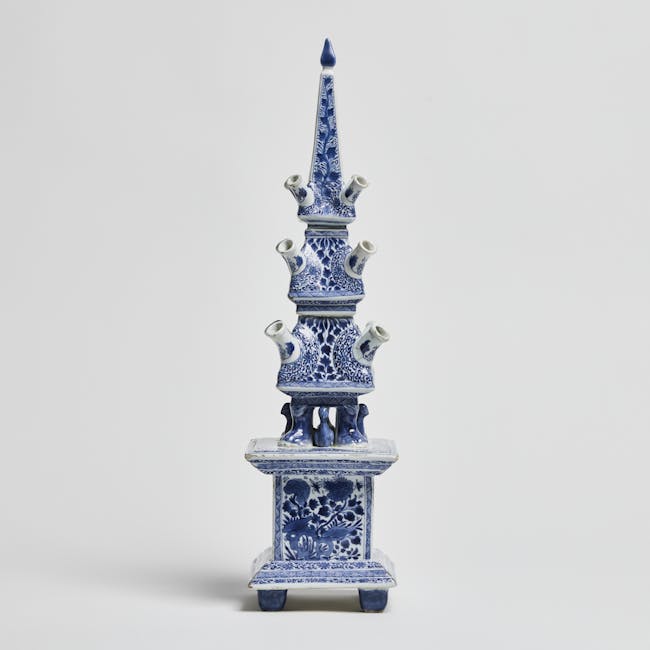An unusually large Chinese porcelain flower pyramid, decorated in a bright underglaze blue. The obelisk-shaped upper section, is divided into three trapezoid tiers - the top one ending in a pointed pinnacle with a blue finial. Each tier has four spouts - one on each corner - angled upright to hold flowers. The obelisk is held up by four claw feet, with seated birds in between them. The square base, has wide stepped plinths at the top and bottom, both decorated with three patterned bands. The unglazed base is raised with pad feet and has a hole in the middle. The body of the obelisk is decorated with a dense pattern of stylized foliage, each spout surrounded by a more open decoration of swirling foliage and flowers. The spouts themselves just have a simple lotus flower and some leaves. The square panels on each side of the base, are alternately decorated with charming small Chinese landscapes and rocks with flowering plants.
Chinese porcelain flower pyramids are rare, undoubtedly considered exclusive luxury items when they arrived in Europe. Such objects would have been made to order for Dutch private traders and their customers, taking many years before arriving in Amsterdam by ship. These private orders - referred to as Chine-de-Commande - often included objects with European shapes and decoration. Flower pyramids would have been used as ostentatious table centrepieces, with a variety of exotic blooms placed in the spouts. They were no doubt meant to impress the onlooker and display the wealth and good taste of the owner. This large Chinese porcelain version was probably considered even more exotic than its Delft equivalent, as these examples are even rarer than their Delftware cousins.
Similar vases (all smaller) with a more European decoration on the base panels, are in the Victoria & Albert Museum, London (acc.nr. FE.3&A-1979), Peabody Essex Museum, Salem (acc.nr. E82654), Kunstmuseum, The Hague (acc.nr. 0323995) and the Hong Kong Museum of Art (acc.nr. C1994.0010). The Groninger Museum has a pair of vases (inv.nr. 1899.0149) as does the RA Collection (inv.nr. 782). The Asian Civilisations Museum, Singapore has an unusual example with later polychrome decoration added in Europe (acc.nr. 2015-00201).








